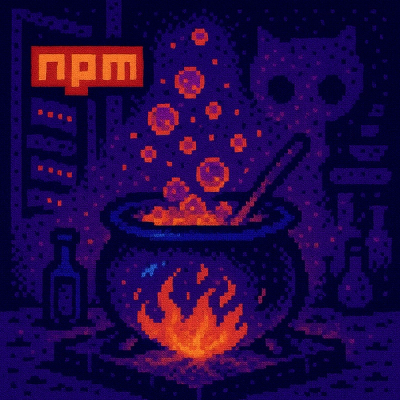
Research
/Security News
9 Malicious NuGet Packages Deliver Time-Delayed Destructive Payloads
Socket researchers discovered nine malicious NuGet packages that use time-delayed payloads to crash applications and corrupt industrial control systems.

String.prototype modificationsAs of v3.0 the Chalk-style syntax (magical getter) is no longer used.
Please visit History for migration paths supporting that syntax.
$ npm install --save kleur
import kleur from 'kleur';
// basic usage
kleur.red('red text');
// chained methods
kleur.blue().bold().underline('howdy partner');
// nested methods
kleur.bold(`${ white().bgRed('[ERROR]') } ${ kleur.red().italic('Something happened')}`);
const { bold, green } = require('kleur');
console.log(bold().red('this is a bold red message'));
console.log(bold().italic('this is a bold italicized message'));
console.log(bold().yellow().bgRed().italic('this is a bold yellow italicized message'));
console.log(green().bold().underline('this is a bold green underlined message'));

const { yellow, red, cyan } = require('kleur');
console.log(yellow(`foo ${red().bold('red')} bar ${cyan('cyan')} baz`));
console.log(yellow('foo ' + red().bold('red') + ' bar ' + cyan('cyan') + ' baz'));

Toggle color support as needed; kleur includes simple auto-detection which may not cover all cases.
Note: Both
kleurandkleur/colorsshare the same detection logic.
import kleur from 'kleur';
// manually disable
kleur.enabled = false;
// or use another library to detect support
kleur.enabled = require('color-support').level > 0;
console.log(kleur.red('I will only be colored red if the terminal supports colors'));
Important:
Colors will be disabled automatically in non TTY contexts. For example, spawning another process or piping output into another process will disable colorization automatically. To force colors in your piped output, you may do so with theFORCE_COLOR=1environment variable:
$ node app.js #=> COLORS
$ node app.js > log.txt #=> NO COLORS
$ FORCE_COLOR=1 node app.js > log.txt #=> COLORS
$ FORCE_COLOR=0 node app.js > log.txt #=> NO COLORS
Any kleur method returns a String when invoked with input; otherwise chaining is expected.
It's up to the developer to pass the output to destinations like
console.log,process.stdout.write, etc.
The methods below are grouped by type for legibility purposes only. They each can be chained or nested with one another.
Colors:
black — red — green — yellow — blue — magenta — cyan — white — gray — grey
Backgrounds:
bgBlack — bgRed — bgGreen — bgYellow — bgBlue — bgMagenta — bgCyan — bgWhite
Modifiers:
reset — bold — dim — italic* — underline — inverse — hidden — strikethrough*
* Not widely supported
When you only need a few colors, it doesn't make sense to import all of kleur because, as small as it is, kleur is not treeshakeable, and so most of its code will be doing nothing. In order to fix this, you can import from the kleur/colors submodule which fully supports tree-shaking.
The caveat with this approach is that color functions are not chainable~!
Each function receives and colorizes its input. You may combine colors, backgrounds, and modifiers by nesting function calls within other functions.
// or: import * as kleur from 'kleur/colors';
import { red, underline, bgWhite } from 'kleur/colors';
red('red text');
//~> kleur.red('red text');
underline(red('red underlined text'));
//~> kleur.underline().red('red underlined text');
bgWhite(underline(red('red underlined text w/ white background')));
//~> kleur.bgWhite().underline().red('red underlined text w/ white background');
Note: All the same colors, backgrounds, and modifiers are available.
Conditional Support
The kleur/colors submodule also allows you to toggle color support, as needed.
It includes the same initial assumptions as kleur, in an attempt to have colors enabled by default.
Unlike kleur, this setting exists as kleur.$.enabled instead of kleur.enabled:
import * as kleur from 'kleur/colors';
// or: import { $, red } from 'kleur/colors';
// manually disabled
kleur.$.enabled = false;
// or use another library to detect support
kleur.$.enabled = require('color-support').level > 0;
console.log(red('I will only be colored red if the terminal supports colors'));
Using Node v10.13.0
chalk :: 5.303ms
kleur :: 0.488ms
kleur/colors :: 0.369ms
ansi-colors :: 1.504ms
# All Colors
ansi-colors x 177,625 ops/sec ±1.47% (92 runs sampled)
chalk x 611,907 ops/sec ±0.20% (92 runs sampled)
kleur x 742,509 ops/sec ±1.47% (93 runs sampled)
kleur/colors x 881,742 ops/sec ±0.19% (98 runs sampled)
# Stacked colors
ansi-colors x 23,331 ops/sec ±1.81% (94 runs sampled)
chalk x 337,178 ops/sec ±0.20% (98 runs sampled)
kleur x 78,299 ops/sec ±1.01% (97 runs sampled)
kleur/colors x 104,431 ops/sec ±0.22% (97 runs sampled)
# Nested colors
ansi-colors x 67,181 ops/sec ±1.15% (92 runs sampled)
chalk x 116,361 ops/sec ±0.63% (94 runs sampled)
kleur x 139,514 ops/sec ±0.76% (95 runs sampled)
kleur/colors x 145,716 ops/sec ±0.97% (97 runs sampled)
This project originally forked ansi-colors.
Beginning with kleur@3.0, the Chalk-style syntax (magical getter) has been replaced with function calls per key:
// Old:
c.red.bold.underline('old');
// New:
c.red().bold().underline('new');
As I work more with Rust, the newer syntax feels so much better & more natural!
If you prefer the old syntax, you may migrate to ansi-colors or newer chalk releases.
Versions below kleur@3.0 have been officially deprecated.
MIT © Luke Edwards
Chalk is a popular npm package similar to kleur that allows for styling terminal strings. It offers a more extensive API and additional features like template literal support and custom themes, but it is slightly larger in size compared to kleur.
Colors is another package that provides ANSI color formatting for text in the terminal. It extends String.prototype to add color properties, which some developers may find less clean than the functional approach taken by kleur.
Ansi-colors is a lightweight package that focuses on performance. Like kleur, it does not extend String.prototype and has a chainable API, but it has fewer dependencies and is designed to be as minimal as possible.
FAQs
The fastest Node.js library for formatting terminal text with ANSI colors~!
The npm package kleur receives a total of 31,950,992 weekly downloads. As such, kleur popularity was classified as popular.
We found that kleur demonstrated a not healthy version release cadence and project activity because the last version was released a year ago. It has 1 open source maintainer collaborating on the project.
Did you know?

Socket for GitHub automatically highlights issues in each pull request and monitors the health of all your open source dependencies. Discover the contents of your packages and block harmful activity before you install or update your dependencies.

Research
/Security News
Socket researchers discovered nine malicious NuGet packages that use time-delayed payloads to crash applications and corrupt industrial control systems.

Security News
Socket CTO Ahmad Nassri discusses why supply chain attacks now target developer machines and what AI means for the future of enterprise security.

Security News
Learn the essential steps every developer should take to stay secure on npm and reduce exposure to supply chain attacks.